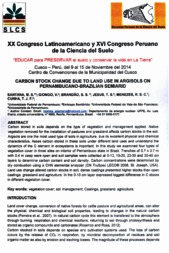Carbon stock change due to land use in argisols on pernambucano-brazillan semiarid
Carbon stock change due to land use in argisols on pernambucano-brazillan semiarid
Autoria: SANTANA, M. S.; GIONGO, V.; BRANDÃO, S. S.; JESUS, T. S.; MENEZES, R. S. C.; CUNHA, T. J. F.
Resumo: Carbon stored in soils depends on the type of vegetation and management applied. Native vegetation removed for the installation of pastures and grassland affects carbon stocks in the soil.Argisols are one the most used type of soils in agriculture, due its excellent physical and chemical characteristics. Asses carbon stored in these soils under different land uses and understand the dynamics of the C element in ecosystems is important. In this study we examined four types of vegetation cover in three sites on interior of Pernambuco state in Brazil. Trenches of 0.7 x 0.7 m with 0.4 m deep were open and soil samples were collected at 0-10, 10-20, 20-30 and 30-40 cm layers to determine carbon content and soil density. Carbon concentrations were determined by dry combustion using a CHN elemental analyzer (CN TruSpec LECO® 2006, St. Joseph, USA). Land use change altered carbon stocks in soil, dense caatinga presented higher stocks than open caatinga, grassland and agriculture. In the 0-10 cm layer expressed biggest difference in C stocks in different vegetation cover.
Ano de publicação: 2014
Tipo de publicação: Artigo em anais e proceedings
Unidade: Embrapa Semiárido
Palavras-chave: Caatinga, Cobertura Vegetal, Estoque de carbono, Manejo do Solo, Patagem, Recurso natural, Soil, Solo, Uso do solo, Vegetação nativa
Observações
1 - Por padrão são exibidas publicações dos últimos 20 anos. Para encontrar publicações mais antigas, configure o filtro ano de publicação, colocando o ano a partir do qual você deseja encontrar publicações. O filtro está na coluna da esquerda na busca acima.
2 - Para ler algumas publicações da Embrapa (apenas as que estão em formato ePub), é necessário ter, no celular ou computador, um desses softwares gratuitos. Sistemas Android: Google Play Livros; IOS: iBooks; Windows e Linux: software Calibre.
Acesse outras publicações
Acesse a Base de Dados da Pesquisa Agropecuária (BDPA) para consultar o acervo completo das bibliotecas da Embrapa.

